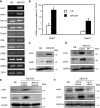JNK signaling maintains the mesenchymal properties of multi-drug resistant human epidermoid carcinoma KB cells through snail and twist1
- PMID: 23557251
- PMCID: PMC3646674
- DOI: 10.1186/1471-2407-13-180
JNK signaling maintains the mesenchymal properties of multi-drug resistant human epidermoid carcinoma KB cells through snail and twist1
Abstract
Background and methods: In addition to possess cross drug resistance characteristic, emerging evidences have shown that multiple-drug resistance (MDR) cancer cells exhibit aberrant metastatic capacity when compared to parental cells. In this study, we explored the contribution of c-Jun N-terminal kinases (JNK) signaling to the mesenchymal phenotypes and the aberrant motile capacity of MDR cells utilizing a well characterized MDR cell line KB/VCR, which is established from KB human epidermoid carcinoma cells by vincristine (VCR), and its parental cell line KB.
Results: Taking advantage of experimental strategies including pharmacological tool and gene knockdown, we showed here that interference with JNK signaling pathway by targeting JNK1/2 or c-Jun reversed the mesenchymal properties of KB/VCR cells to epithelial phenotypes and suppressed the motile capacity of KB/VCR cells, such as migration and invasion. These observations support a critical role of JNK signaling in maintaining the mesenchymal properties of KB/VCR cells. Furthermore, we observed that JNK signaling may control the expression of both snail and twist1 in KB/VCR cells, indicating that both snail and twist1 are involved in controlling the mesenchymal characteristics of KB/VCR cells by JNK signaling.
Conclusion: JNK signaling is required for maintaining the mesenchymal phenotype of KB/VCR cells; and JNK signaling may maintain the mesenchymal characteristics of KB/VCR cells potentially through snail and twist1.
Figures





Similar articles
-
Inhibition of Akt activity induces the mesenchymal-to-epithelial reverting transition with restoring E-cadherin expression in KB and KOSCC-25B oral squamous cell carcinoma cells.J Exp Clin Cancer Res. 2009 Feb 26;28(1):28. doi: 10.1186/1756-9966-28-28. J Exp Clin Cancer Res. 2009. PMID: 19243631 Free PMC article.
-
JNK is required for maintaining the tumor-initiating cell-like properties of acquired chemoresistant human cancer cells.Acta Pharmacol Sin. 2015 Sep;36(9):1099-106. doi: 10.1038/aps.2015.58. Epub 2015 Aug 3. Acta Pharmacol Sin. 2015. PMID: 26235742 Free PMC article.
-
Twist1 and Snail link Hedgehog signaling to tumor-initiating cell-like properties and acquired chemoresistance independently of ABC transporters.Stem Cells. 2015 Apr;33(4):1063-74. doi: 10.1002/stem.1955. Stem Cells. 2015. PMID: 25588661
-
Copper depletion inhibits CoCl2-induced aggressive phenotype of MCF-7 cells via downregulation of HIF-1 and inhibition of Snail/Twist-mediated epithelial-mesenchymal transition.Sci Rep. 2015 Jul 15;5:12410. doi: 10.1038/srep12410. Sci Rep. 2015. PMID: 26174737 Free PMC article.
-
Pantoprazole pretreatment elevates sensitivity to vincristine in drug-resistant oral epidermoid carcinoma in vitro and in vivo.Biomed Pharmacother. 2019 Dec;120:109478. doi: 10.1016/j.biopha.2019.109478. Epub 2019 Sep 27. Biomed Pharmacother. 2019. PMID: 31568987
Cited by
-
The emerging role of Twist proteins in hematopoietic cells and hematological malignancies.Blood Cancer J. 2014 Apr 25;4(4):e206. doi: 10.1038/bcj.2014.22. Blood Cancer J. 2014. PMID: 24769647 Free PMC article. Review.
-
E-cadherin increasing multidrug resistance protein 1 via hypoxia-inducible factor-1α contributes to multicellular resistance in colorectal cancer.Tumour Biol. 2016 Jan;37(1):425-35. doi: 10.1007/s13277-015-3811-6. Epub 2015 Jul 30. Tumour Biol. 2016. PMID: 26219897
-
Hypoxia-Induced Epithelial-Mesenchymal Transition in Cancers: HIF-1α and Beyond.Front Oncol. 2020 Apr 8;10:486. doi: 10.3389/fonc.2020.00486. eCollection 2020. Front Oncol. 2020. PMID: 32322559 Free PMC article. Review.
-
Diversin is overexpressed in breast cancer and accelerates cell proliferation and invasion.PLoS One. 2014 May 23;9(5):e98591. doi: 10.1371/journal.pone.0098591. eCollection 2014. PLoS One. 2014. PMID: 24858714 Free PMC article.
-
Role and mechanism of Twist1 in modulating the chemosensitivity of FaDu cells.Mol Med Rep. 2014 Jul;10(1):53-60. doi: 10.3892/mmr.2014.2212. Epub 2014 May 6. Mol Med Rep. 2014. PMID: 24805866 Free PMC article.
References
-
- Redmond KM, Wilson TR, Johnston PG, Longley DB. Resistance mechanisms to cancer chemotherapy. Front Biosci. 2008;13:5138–5154. - PubMed
-
- Yamauchi K, Yang M, Hayashi K, Jiang P, Yamamoto N, Tsuchiya H, Tomita K, Moossa AR, Bouvet M, Hoffman RM. Induction of cancer metastasis by cyclophosphamide pretreatment of host mice: an opposite effect of chemotherapy. Cancer Res. 2008;68(2):516–520. doi: 10.1158/0008-5472.CAN-07-3063. - DOI - PubMed
-
- De Larco JE, Wuertz BR, Manivel JC, Furcht LT. Progression and enhancement of metastatic potential after exposure of tumor cells to chemotherapeutic agents. Cancer Res. 2001;61(7):2857–2861. - PubMed
-
- Xiong W, Ren ZG, Qiu SJ, Sun HC, Wang L, Liu BB, Li QS, Zhang W, Zhu XD, Liu L. Residual hepatocellular carcinoma after oxaliplatin treatment has increased metastatic potential in a nude mouse model and is attenuated by Songyou Yin. BMC Cancer. 2010;10:219. doi: 10.1186/1471-2407-10-219. - DOI - PMC - PubMed
Publication types
MeSH terms
Substances
LinkOut - more resources
Full Text Sources
Other Literature Sources
Research Materials
Miscellaneous

